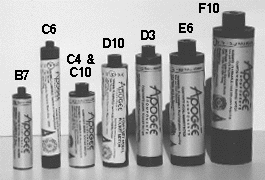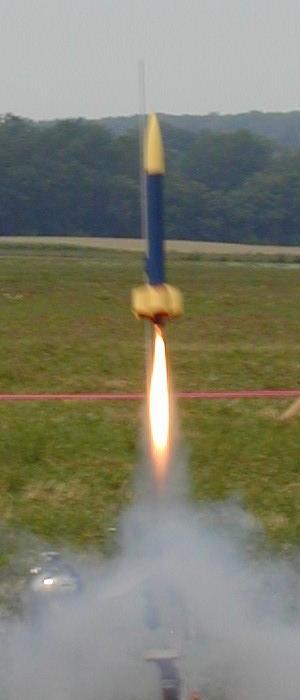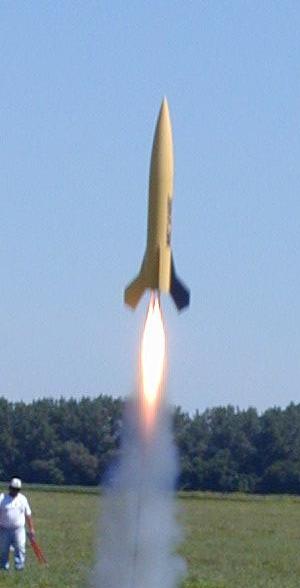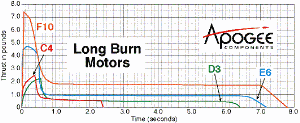Apogee Components Medalist Motors
Apogee Components - Medalist Motors {Motor}
Contributed by Nick Esselman
| Published: | 2010-11-13 |
| Manufacturer: | Apogee Components  |
 (10/10/01) Apogee's
Medalist composite motor offerings allow a flier some variety to the standard
suite of motors. Especially for 18mm rockets that consistently fly on Estes and
Quest motors.
(10/10/01) Apogee's
Medalist composite motor offerings allow a flier some variety to the standard
suite of motors. Especially for 18mm rockets that consistently fly on Estes and
Quest motors.
Here is what Apogee says about their motors: "The Medalist line of rockets motors feature ultra - high-energy composite propellant and are designed for special applications: either high thrust for launching heavier models, or extremely long burn times for achieving ultra-high altitudes. The "hefty" lifting motors are the B7, C6, C10, and D10. All the others (C4, D3, E6, and F10) are long burn duration motors intended for use in low-mass, extreme-altitude rockets. All are produced in "standard" motor diameters for easy use in your existing rockets. Includes an igniter and instructions for use."
I have flown the B7, C4, C10, D3, D10, E6 and F10 motors. That leaves the 13mm C6 as the only one I have not flown.
Rocket Vision Six-Pack D10-5
The B7 and the C6 are 13mm motors. Take your Estes Gnome to heights only imaginable on A3's and A10's! The B7 is 6mm longer than a standard Estes motor and the C6 is nearly twice the length. So be sure to check your center of gravity and you might want to decide if you are going to use these motors before you build.
The C4, C10, D3, and D10 are 18mm motors. The C4 and C10 are 19mm shorter than a standard Estes motor and therefore you should use an adaptor. I cut my adapter from a spent Estes motor casing. The D10 is exactly the same dimensions as an Estes 18mm motor, while the D3 is 7mm longer. The extra length only impacts those rockets with motor hooks, but they can still be used with some tape for retention. Again, be sure to check your CG/CP relationship.
The E6 is the 24mm motor and the F10 is the 29mm motor. Again the E6 is just 7mm longer than a standard Estes D12 motor, while the F10 is in between the lengths of an Aerotech EconoJet F20 and G35.
If you are used to Estes motors be prepared for two things. First these are composite motors and they give a nice "roar" compared to the black powder motors. Second, the ejection charges really "pop" on these motors so be sure to have a solid recovery system. The old elastic/plastic are not going to cut it, in my experience. Use double the wadding!
FLIGHT:
For my 13mm experience, I put a B7-6 into my quickly-built Rocket Rollie and took it for a spin. Wow! And I lost it!
I have flown the C4 in my Custom Razor and my scratch 2-motor, cluster Red Dog. Looking back at my flight logs I noted nice tracking smoke and my first experience with the stronger ejection charges.
Modified Nordic Meanie on 3x D10-7's (all
lit)
I have flown the C10 on the same two rockets. Once on the Razor and twice on the Red Dog. I flew it in a third recently; in my new Estes Night Wing™ which makes a nice combination on a C10-4. The motor really gets these rockets off the pad quickly, and with two (2) motors in my Red Dog....varrooooom. Again, I noted nice tracking smoke.
I've only flown one D3 and due to my experience at the time, didn't allow the flight to be successful. I flew it in my Vaughn Brothers Blobbo. It was under-powered and did a short, slow arc into the ground while still under thrust.
My favorite is the D10. I have currently flown seven (7) of these. Three (3) on my Blobbo, one in my Rocket Vision's Six-Pack, and three (3) as a cluster in my Modified Nordic Rocketry Meanie. I struggled on the first two uses of this motor (before it became a favorite). I tried (3) apogee ignitors before using a different kind for the first use on my Blobbo. Then for a second flight on the Blobbo, the motor CATO'd destroying the back-end. Apogee replaced the motor, I rebuilt the Blobbo and the next flight restored my faith. Then flying these motors at NARAM-43 on my Six Pack (pictured above) and my 3-motor Meanie (pictured) made me desire to have more. So I've placed an order.
After many flights on my original Vauhn Brothers' Blobbo it was retired after spending too long in a tree and rain storms, but I kept the fins and nose cone. I recently rebuilt and modified it, into my Blobbo 24mm. I built this rocket FOR the Apogee E6. The thrust-ring and hook were all set to handle the length of the E6. And how did it go? Perfect. ( here is a very short video of it coming off the pad). Not a lot of smoke produced from the E6, but a nice initial thrust got the rocket going straight up and then a 7 second burn was cool to hear and see. It's not like it took the rocket to extreme altitudes, because of the weight, but to have it under a long thrust was just fun to watch. I'll definately be buying more of these for this rocket.
At NARAM-43. I also flew the F10-6 in my Modified Nordic Rocketry Meanie. I tried to get a video of that, but messed up. Anyhow, the rocket was borderline too heavy but it did come off of the pad and straight into the air. It was interesting because it was still under thrust but seemed to run out of steam. Here's my take. The high initial thrust of the F10 pushed the rocket into the air nicely, but the weight and drag of the rocket was slightly more than the low thrust and especially that last second. The Meanie had actually arced over (apogee) while under thrust making the delay too long. It was recovered without a problem.
 My only real complaint are the ignitors. They generally
come with a Copperhead type ignitor (other than the C4 and D3 which have a
special small head ignitor). the Copperheads are inconsistent. Also, a little
Estes or Quest launch controller is probably not going to light these. You will
need a 12V system. I have been using the Estes Command Controller (two 7.2V
batteries) for the last 5 years and it has handled everything very well!
My only real complaint are the ignitors. They generally
come with a Copperhead type ignitor (other than the C4 and D3 which have a
special small head ignitor). the Copperheads are inconsistent. Also, a little
Estes or Quest launch controller is probably not going to light these. You will
need a 12V system. I have been using the Estes Command Controller (two 7.2V
batteries) for the last 5 years and it has handled everything very well!
Overall, these motors give you a new experience for traditional Estes-motor powered rockets. Take a few building considerations for the variations in motor sizes and be prepared for the stronger ejection charges. Price will also need to be considered, because it is about a 3:1 ratio, in other words you can get (3) Estes motors for about a the price of (1) of these Apogee motors. Okay, so these may not become your main flying motors, but you should at least put away little extra lawn-mowing or shoveling money and buy a few of these. You'll want more and you should see the faces of people how have never experienced a composite motor before. The "roar" is exciting. Sure, sure, its not a "J", "K" or more, but I still fly these in my $9.95 Estes kits in my little field and without a waiver!. I give these motors an OVERALL rating of 4 ½ points.
 |
 |
John Eric Thompson (October 20, 2016)
I happen to have the following in mint condition that I am going to put to use this year:
10.5mm
1/4 A2-4
1/2 A2-2
1/2 A2-4
1/2 A2-6
A2-3 (x2 packages)
A2-5
A2-7
B2-3
B2-5
B2-7
13mm
B7-4
C6-4
C6-7
18mm
C4-7 (x3)
 |
 |
D.M. (June 4, 2005)